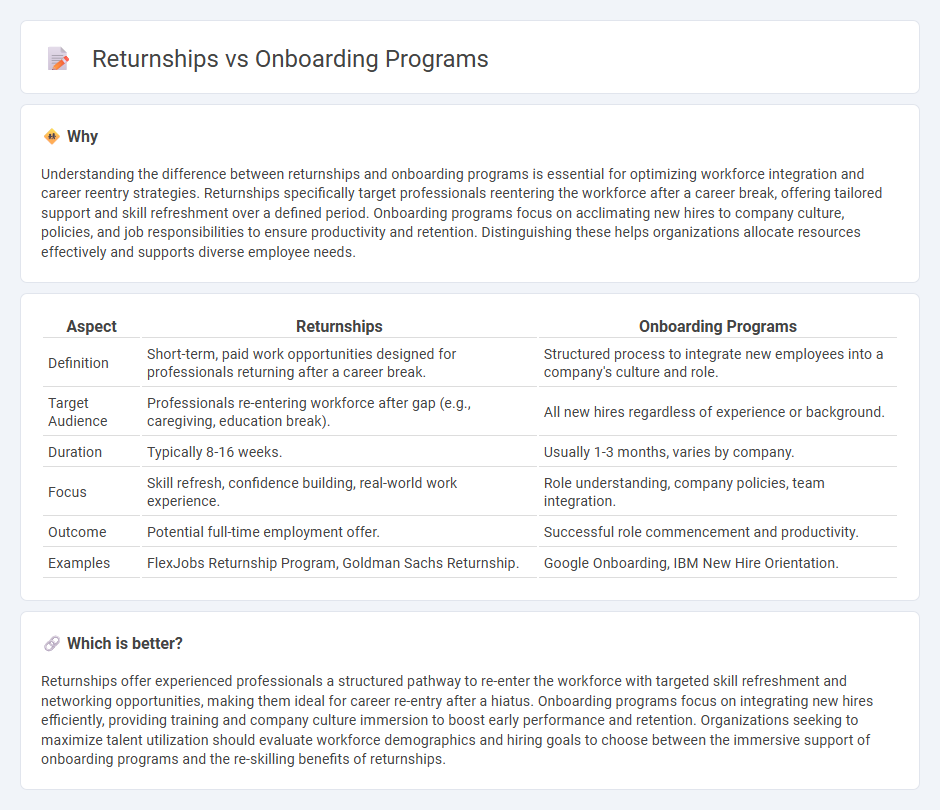
Returnships offer structured, short-term opportunities designed to help professionals re-enter the workforce after a career break, focusing on skill refreshment and confidence building. Onboarding programs provide comprehensive training and integration processes for new hires, aiming to accelerate productivity and cultural assimilation within the organization. Discover the key differences and benefits of returnships versus onboarding programs to optimize your employment strategy.
Why it is important
Understanding the difference between returnships and onboarding programs is essential for optimizing workforce integration and career reentry strategies. Returnships specifically target professionals reentering the workforce after a career break, offering tailored support and skill refreshment over a defined period. Onboarding programs focus on acclimating new hires to company culture, policies, and job responsibilities to ensure productivity and retention. Distinguishing these helps organizations allocate resources effectively and supports diverse employee needs.
Comparison Table
| Aspect | Returnships | Onboarding Programs |
|---|---|---|
| Definition | Short-term, paid work opportunities designed for professionals returning after a career break. | Structured process to integrate new employees into a company's culture and role. |
| Target Audience | Professionals re-entering workforce after gap (e.g., caregiving, education break). | All new hires regardless of experience or background. |
| Duration | Typically 8-16 weeks. | Usually 1-3 months, varies by company. |
| Focus | Skill refresh, confidence building, real-world work experience. | Role understanding, company policies, team integration. |
| Outcome | Potential full-time employment offer. | Successful role commencement and productivity. |
| Examples | FlexJobs Returnship Program, Goldman Sachs Returnship. | Google Onboarding, IBM New Hire Orientation. |
Which is better?
Returnships offer experienced professionals a structured pathway to re-enter the workforce with targeted skill refreshment and networking opportunities, making them ideal for career re-entry after a hiatus. Onboarding programs focus on integrating new hires efficiently, providing training and company culture immersion to boost early performance and retention. Organizations seeking to maximize talent utilization should evaluate workforce demographics and hiring goals to choose between the immersive support of onboarding programs and the re-skilling benefits of returnships.
Connection
Returnships and onboarding programs both facilitate smoother re-entry into the workforce by offering structured support and skill refreshment, enhancing employee retention and productivity. Returnships specifically target professionals returning after career breaks, integrating tailored training within standard onboarding frameworks to address unique challenges. Effective onboarding programs incorporate these elements to accelerate job readiness, foster engagement, and reduce time-to-productivity for returning employees.
Key Terms
Onboarding Programs:
Onboarding programs streamline new employee integration by providing structured training, clear role expectations, and access to company resources, resulting in higher retention rates and improved job performance. These programs often include mentorship opportunities, technology onboarding, and culture immersion to accelerate productivity. Explore effective onboarding strategies to enhance employee experience and business success.
Orientation
Onboarding programs emphasize comprehensive orientation to integrate new employees into company culture, policies, and workflows, often spanning several weeks. Returnships specifically tailor orientation to experienced professionals re-entering the workforce, addressing skills refreshment and confidence rebuilding. Explore how tailored orientation strategies impact employee engagement and retention.
Training
Onboarding programs are structured training initiatives designed to integrate new employees by providing role-specific skills, company culture understanding, and compliance knowledge. Returnships focus on reskilling and upskilling professionals re-entering the workforce after a career break, combining training with mentorship tailored to bridge gaps and rebuild confidence. Explore the nuances of onboarding programs and returnships to optimize workforce development strategies.
Source and External Links
12 Effective Onboarding Programs (With Trends and Examples) - Onboarding programs help new employees feel welcomed, prepared, and integrated by introducing them to company culture, role responsibilities, colleagues, and workflows through various techniques like goal setting, welcome kits, and interactive courses.
11 Companies with the Best Onboarding Programs - Deel - Companies like Hubspot use structured and comprehensive onboarding processes, including in-depth product training and remote work adaptation, to foster employee success and strong engagement from day one.
Complete Employee Onboarding Guide - SHRM - A quality onboarding program integrates new hires by combining orientation, mentorship, team-building activities, facility tours, and culture immersion, with some companies using innovative tactics such as quick workstation setup and community tours to accelerate productivity and engagement.
 dowidth.com
dowidth.com